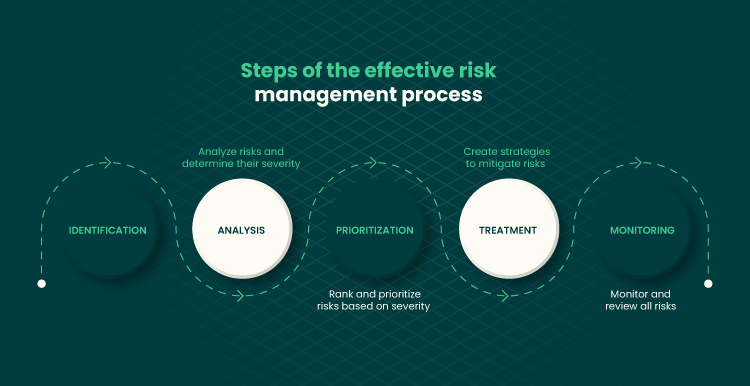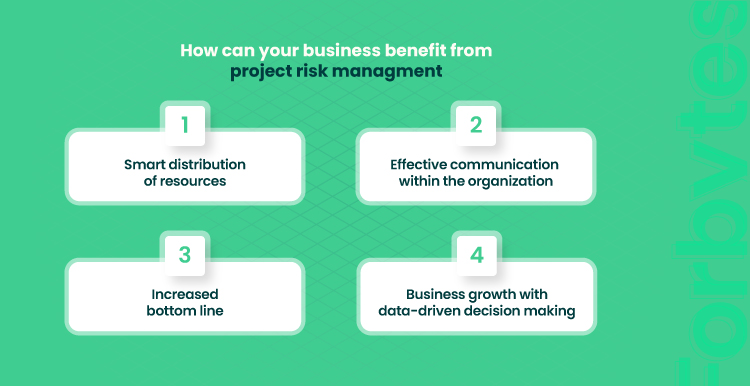Every software development project is prone to be affected by different types of risks that, without proper preparation, can have severe effects. This is why project risk management is so important, and why the role of a project manager is essential to a development team. In this article, our senior project manager Olga Ievchyn helped us take a closer look at risk management and its importance in software development.
What is risk management?
Project risk management is a complex process of identifying, analyzing, and categorizing potential risks that can occur during the project’s lifetime and creating response strategies that would keep the project on track.
Effective risk management in software engineering is not reactive. Rather, it consists of careful planning for possible risks ahead of time and figuring out how to manage them once they occur. Or, if possible, avoid them altogether. It is significant to remember that risks can be both negative (that lead to Threats) and positive (that open up Opportunities). A good example of an Opportunity is a team finishing their tasks ahead of schedule. For that reason, risk management should not only be about mitigating the negative effects of risks but also about taking advantage of positive ones and turning them into Opportunities.
Steps of the Effective Risk Management Process
To be effective, risk management must consist of several equally significant steps taken in a certain order.

1. Identification. The goal of this step is to identify as many potential risks as possible. There are many ways of doing this, such as looking at company history, having discussions and brainstorming sessions, getting insights from colleagues or outside experts, etc.
2. Analysis. The second step involves analyzing the identified risks and determining their severity by examining which and how many aspects of the project will be affected by each risk.
3. Prioritization. After all potential risks are analyzed, it is important to rank and prioritize them based on their severity. This step helps obtain a comprehensive picture of project exposure and plays a key role in choosing how to deal with each risk.
4. Treatment. Also known as Risk Response Planning, this step refers to creating strategies to mitigate risks and their effects on the project, allowing for successful and smooth execution.
5. Monitoring. Effective risk management is a continuous process that requires constant monitoring and reviewing. This, in turn, allows project managers to predict future risks more accurately and even avoid them altogether.
Sources of risks
The most common risks in a software development project are related to:
- Timeframe. Both low and high-maturity projects are quite prone to not meeting deadlines. A study by PMI found that only 64% of high-maturity projects are completed on time. Moreover, the percentage for low-maturity projects is even lower — 36%.
- Cost. Another big issue for software development projects is staying within previously agreed-upon cost estimates. A survey published by HBR found that IT projects overrun their budgets by 27% on average. Moreover, 1 in 6 projects is at risk of exceeding its estimate by as much as 200% and becoming the so-called “black swan”.
- Performance. The risk that the end solution will not perform as intended and the goals of the project are not met is always present in software development.
Other types of risks can affect any project, such as risks related to governance, operations, strategy, etc.
Risk management strategies
Since software development projects can be impacted by both negative and positive risks, there are different strategies to handle each type.
How to handle negative risks
1. Avoid. One of the best ways of handling risk is to avoid it altogether. Your project manager can achieve this by finding the factors that can cause this risk and removing them from the project. For example, if there is a possibility that a task will not be completed on time, a PM can work on adjusting the schedule or changing the scope of the task to make sure it meets the deadline.
2. Delegate. Another way of handling risk is by delegating it to a third-party service or technology provider. This strategy comes with the obvious benefit of releasing your team from handling the risk and letting them keep up with the project roadmap. However, this strategy comes with its own risk in relying on a third-party company to deliver the results within agreed-upon time and quality requirements. And this is not always the case.
3. Mitigate. This strategy relies on preparing for the risk ahead of time by implementing practices that would reduce its impact. A good example of risk mitigation is the implementation of unit testing, which, as a study found, can significantly reduce delivery time.
4. Accept. Finally, if none of the previous strategies are acceptable, the only remaining solution is to accept the risk and deal with its effects as they occur.
How to handle positive risks
1. Exploit. This strategy involves close examination of factors that can cause a positive risk, and raising the chances that it occurs and transforms into an Opportunity.
2. Enhance. Closely tied to the previous strategy, this one is about enhancing the effects of the potential risk. This can be, for example, increasing the team size to make sure the task is finished earlier.
3. Share (or Delegate). If your project manager realizes that your team is not able to take full advantage of a positive risk (time constraints, lack of expertise, etc.), he or she can transfer it to another company or service provider. This is a great way to form mutually beneficial partnerships such as joint ventures.
4. Accept. Similar to negative risks, the final strategy is simply accepting the positive risk as it comes along without proactively pursuing it or trying to enhance its effects.
It is important to remember that all of these strategies are not set in stone. A good project manager is not afraid to combine and interchange them to ensure the best outcomes for your business.
How can your business benefit from project risk management
Since a study by PMI found that only 58% of organizations fully understand the value of risk management, let’s outline some of the most significant ways your business can benefit from it.
Smart distribution of resources
Effective risk management allows you to spot areas that require attention and distribute your resources accordingly. By knowing when to provide extra hands for a team or when to terminate a project that will not yield the desired results, you can avoid needle spending and make sure that no money goes to waste.
Effective communication within the organization
Proper risk management conducted by a good project manager involves a lot of discussions with project teams, senior managers, and stakeholders. This generates a better understanding between different departments and creates a healthy working environment where teams share common goals.
Business growth with data-driven decision-making
Documentation created by the project manager provides accurate and up-to-date data that senior leaders can use to make better decisions. This, in turn, results in more value being brought by the project and leads to steady business growth.
Increased bottom line
Risk management and, more specifically, risk identification and response planning, can significantly improve performance and the chances of project success, a study found. A successful software development project can result in a significant boost to the business’s bottom line.

Ensure success with effective project risk management
Risk management is an essential component of successful software development project execution that can help bring the utmost value to your business. If you need assistance with bringing your idea to life — do not hesitate to contact us, we have extensive experience in software development and a record of helping our client-partners reach their goals.








